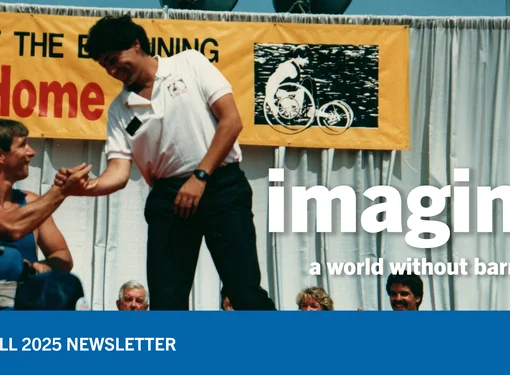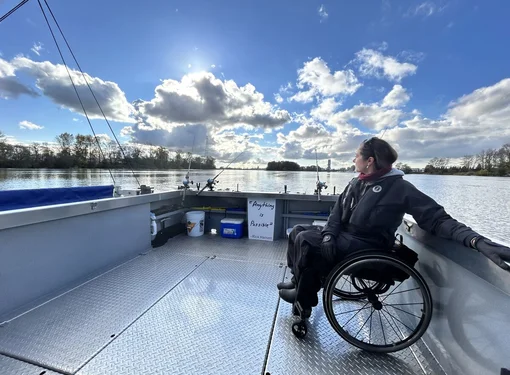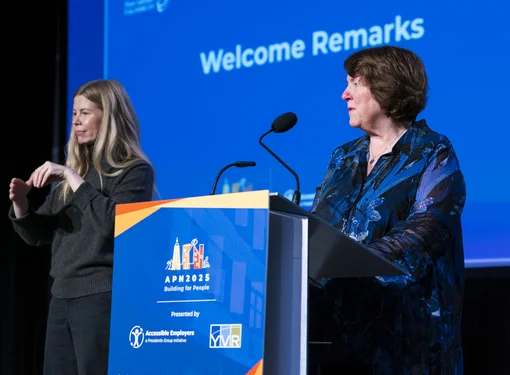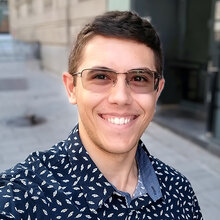You can make Access4All a reality!
Feature: An interview with Brad McCannell, your VP of Access & Inclusion
Melanie Scott sat down with Brad McCannell, Rick Hansen Foundation’s new VP of Access and Inclusion. In this interview, Brad shares his thoughts on how the Foundation is leading the way to make Access4All a reality in Canada.
Melanie: Hi Brad. Can you let our readers know what you did before joining the Foundation?
Brad: I founded the largest TV production company west of Toronto in 1977. Then on Sept. 26, 1980, I broke my neck in a car accident. After recovering from my injuries, I became a producer and writer, working on documentaries, industrial videos, and television.
I had known Rick for several years. Then I met him by chance in an elevator when he was planning Independence '92 – the largest congress on disability ever held. Rick asked me to be project manager, and I said "Yes!"
Independence '92 was life-changing for me. We needed 247 wheelchair-accessible hotel rooms but there were only seven in the Lower Mainland. We had to figure out how to make hotels more accessible. The hotel owners heard the message and said, "What do we do?" And nobody knew. In the process of developing rooms for people with mobility challenges, vision or hearing loss, cognitive impairments, and everything that goes with that – for example, transportation – my team became experts in accessible environments. Nobody else was doing it, it hadn’t been done before.
After the congress, word got out. More and more people were calling me [about accessibility], so I decided to turn accessibility into a business off the side of my desk. Within three months, I had so much work that I shut down my production company and went full-time into access, eventually calling my company Canada Barrier-Free Design.
 Above image: Brad McCannell with Chipper.
Above image: Brad McCannell with Chipper.
"Barrier-free refers to having a specific solution, for a specific disability, in a specific location. Universal design goes exactly the other way. It says, 'Let's build it for everyone.'" Brad McCannell
MS: What do you hear from others about their daily struggles with physical accessibility?
BM: Access is a tricky thing. Because of the success of Rick Hansen, wheelchair users dominated the discussion about disability. In reality, wheelchairs only represent between 6% to 20% – some say closer to 6% – of the entire community of people with disabilities. The experiences of people with vision or hearing loss just routinely get left out of everything. I saw myself as the guy who could help with that; I could bring them into the conversation. Especially if you're someone in a wheelchair, turning to someone and saying, "Forget about the wheelchair guys! They're covered. Let's talk about visual fire alarms." Visual fire alarms weren't even addressed until 2002.
MS: What's the difference between barrier-free design and universal design?
BM: Technically they are two different disciplines in the design community. Barrier-free refers to having a specific solution, for a specific disability, in a specific location. Universal design goes exactly the other way. It says, "Let's build it for everyone."
Everything right now is built for able-bodied males aged 18-55, from chairs to pens. How did that happen? Why are we designing for the most able people while everyone else has to adapt? That's crazy. Universal design expands design parameters to pick up those with disabilities of all kinds, and also young children and aging parents – it kicks open existing parameters so that anyone can use these buildings.
 Above image: Brad McCannell chats with his team.
Above image: Brad McCannell chats with his team.
"We can make this happen. And make a positive impact for all Canadians." Brad McCannell
MS: Why did you join the Foundation? You obviously have a great deal of affection for Rick.
BM: I saw that if I wanted to open really big doors, I needed to work with someone who could pick up the phone and get me in the right room at the right time. Nobody can do that like Rick Hansen. It's not just Rick himself, but everything he's built and the reputation that he brings, that level of confidence. We need cultural change. Stop adding design elements after the fact and start thinking about universal design as part of the initial planning. The only way to do that is to get together a powerful team with experience in changing culture, and that’s Rick Hansen and his team. No one has changed culture the way Rick has. That's why I joined the Foundation last fall.
MS: Can you tell me more about the accessibility initiatives you’re exploring?
BM: Have you heard about LEED? (Leadership in Environmental and Energy Design). Back in the 70s, we recognized that we were damaging the environment. We needed energy conservation, reduced carbon footprints, sustainability, and recycling. LEED was developed out of a need to change building design culture to be more conscientious about the environment. LEED includes incentives for developers – building ratings of bronze, silver, gold, and platinum. Meeting code is bronze. To receive a higher rating, developers need to invest a bit more in design and construction. So municipalities are helping with parallel incentives with LEED certification – reducing the time it takes to get permits processed or increasing the density on the property. These incentives save money for the builder and increase sales revenue. Many new buildings have actively sought gold or platinum ratings because there's a buck to be made while at the same time creating environmentally friendly buildings and marketing them as such.
Rick and my team are looking at the LEED model to see how that model can apply to accessibility in the built environment. We're developing accessibility audits; exploring how to train people to manage these audits; and researching ways to develop experts who can advise government and building professionals. We're also exploring incentives like the LEED bronze, silver, gold, and platinum ratings to encourage developers to use universal design. Incentives that are integrated with legislation that’s going to be there anyway (codes, requirements). It's both a carrot and stick approach.
MS: Any last words, Brad?
BM: It’s a really exciting time to be doing this work. It feels as though the stars are aligning – governments, corporations, developers and the public are becoming more aware of the benefits of universal design. We can make this happen. And make a positive impact for all Canadians.
"Universal design expands design parameters to pick up those with disabilities of all kinds, and also young children and aging parents – it kicks open existing parameters so that anyone can use these buildings." Brad McCannell






